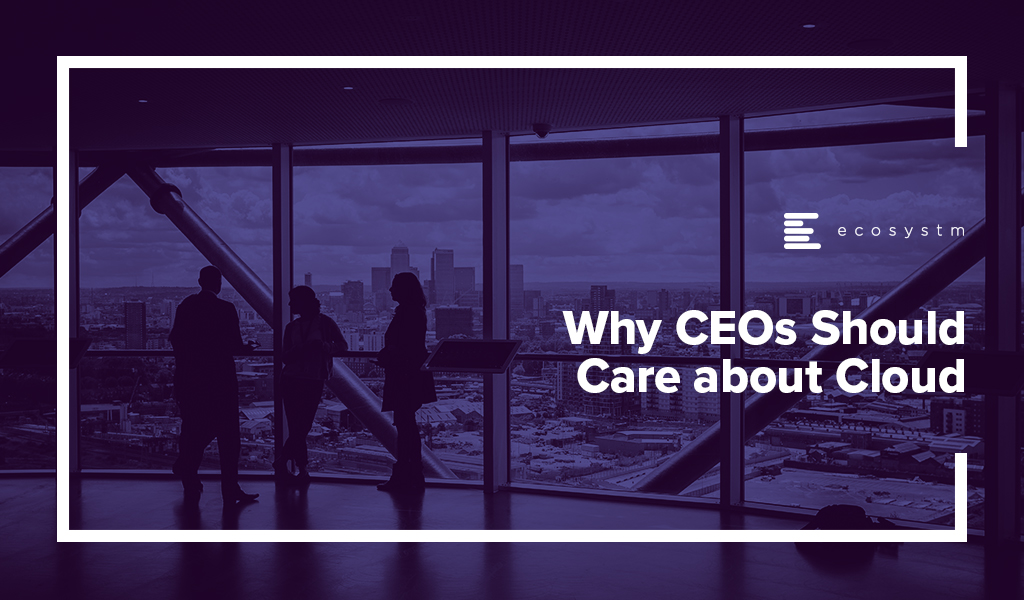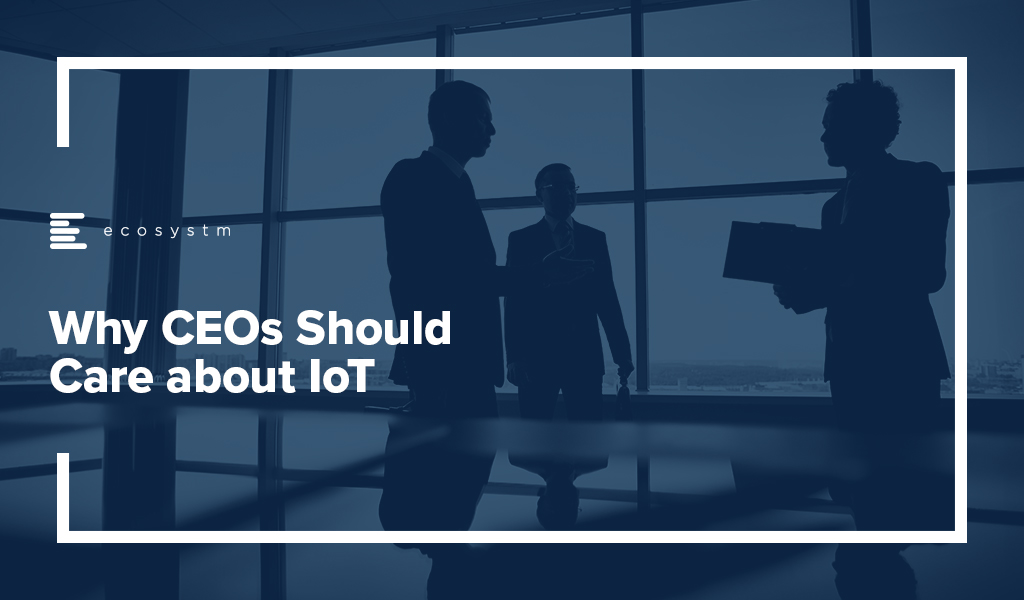CEOs have an active role to play in an organisation’s transformation needs and journey – including in the technology decisions. Last month we spoke about why CEOs should get involved in their organisation’s IoT investments. Now, we look at Cloud – which has been a part of the CIO’s purview so far. Under the current circumstances, most organisations are actively pushing to go digital and the internal discussions will often revolve around empowering remote employees and digital customers. All the technologies that are being evaluated by organisations today have Cloud as their pillar. Increasingly, we see organisations adopt the hybrid and the multi-cloud. And organisations may not have the capabilities – technological and skills – to support the complexity of their Cloud environment. While a CEO does not have to understand the technology fully, it is important to understand the business impact of the technology.
Why should a CEO get involved in and have visibility into an organisation’s Cloud investments? There are a few important reasons.
#1 Cloud is not a cost-saving measure – it will enable you to transform
Organisations have matured in their Cloud adoption and no longer evaluate the benefits of Cloud only in terms of shifting CapEx to OpEx. If we look at the benefits of Cloud adoption, reduction of IT costs is not even in the top 3 benefits that organisations are seeking from Cloud anymore. Operational efficiency and collaboration emerge as key benefits (Figure 1) – while some companies still move to the Cloud for the savings, they stay there for other benefits.
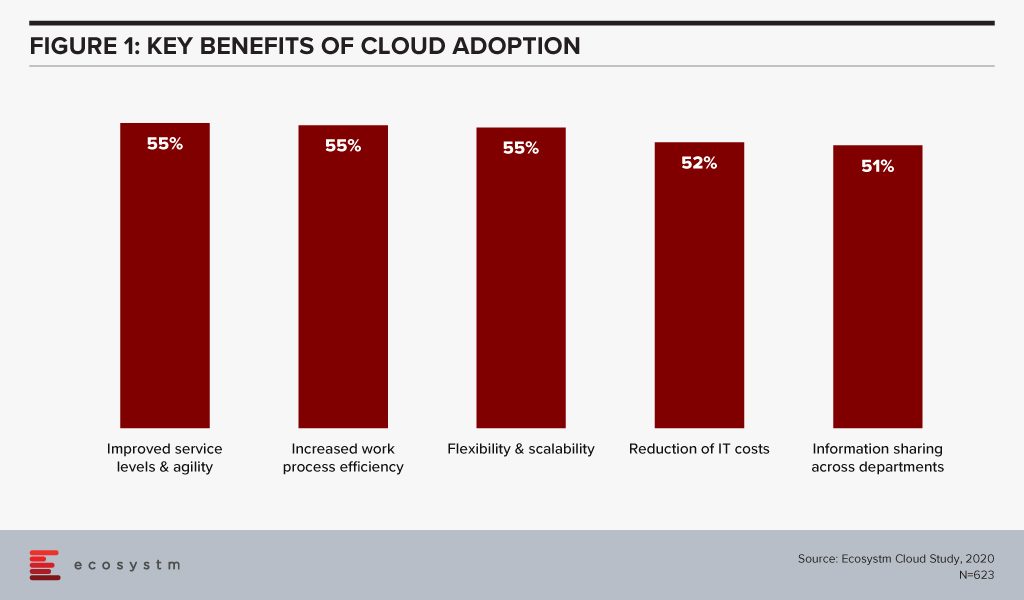
This requires organisations to think of Cloud as a technology empowering their infrastructure and services. Cloud acts as an enabler for ease of doing business, real-time data access for productivity increase, and process automation. This impacts the entire organisation. It also involves prioritising the needs of certain functions over others – definitely not what a CIO should have to do.
If we look at just Cloud storage as an example, organisations can no longer have individual functions and their associated shadow IT teams having their own Cloud storage (and collaboration). This often turns out to be more expensive and there is a lack of consolidated view and management. While organisations forge ahead with the dream of having real-time information sharing across functions, a CIO has to consider the entire organisation’s technological and business needs – a CEO is the best person to guide the CIO in translating the organisation’s vision into IT priorities.
#2 In fact Cloud adoption may not cut costs at all!
Organisations are also re-evaluating the cost benefits of Cloud. Investing in a Cloud infrastructure with a short-term view on the investments involved has led to instances of Cloud solutions being brought back in-house because of rising costs. While security, data privacy and integration remain the key challenges of Cloud adoption (Figure 2), over a third of the organisations find Cloud more expensive than traditional licensing or owning the hardware.
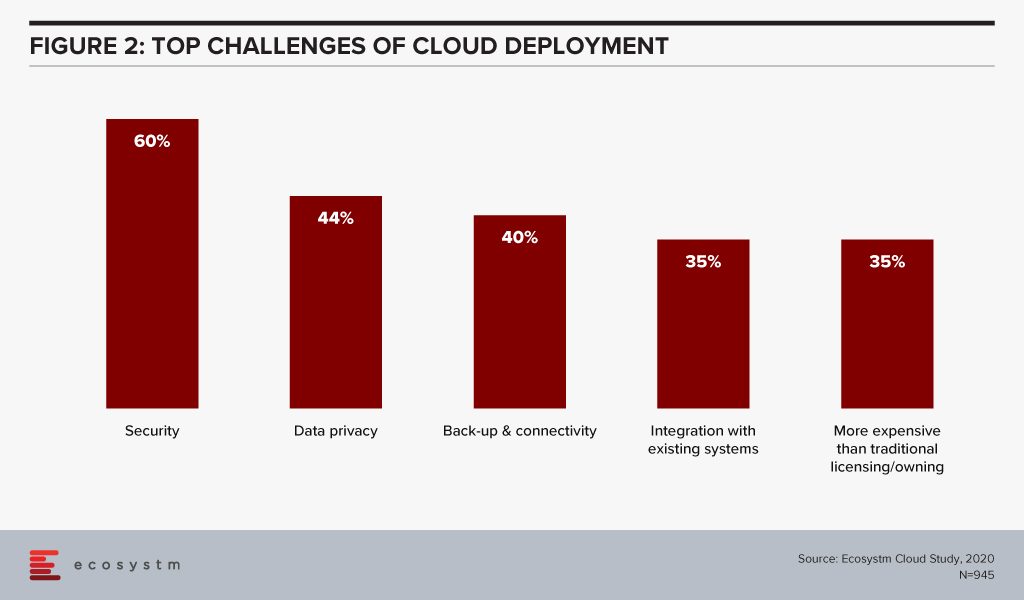
Organisations find that the cost considerations do not stop after the adoption or migration. As businesses use Cloud to scale, there are several aspects that require constant re-evaluation and often further investments – cybersecurity measures, continuous data protection (CDP), disaster recovery management, rightsizing capacity, software and database licenses and day-to-day maintenance, to name a few. In addition to this, the cost of finding and recruiting a team of professionals to manage and maintain the Cloud environment also adds up to the OpEx.
If the CIO is talking about a Cloud migration for cost benefits only, the CEO and the CFO need to step in to evaluate that all factors have been taken into consideration. Moreover, the CIO may not have full visibility of how and where the organisation is looking to scale up or down. It is the CEO’s responsibility to share that vision with the CIO to guide Cloud investments.
#3 Cloud will increasingly be part of all tech adoption considerations
In this disruptive world, CEOs should explore possibilities and understand the technical capabilities which can give organisations an edge over their competitors. It is then up to the CIOs to implement that vision with this larger context in mind. As organisations look to leverage emerging technologies, organisations will adopt Cloud to optimise their resources and workloads.
AI is changing the way organisations need to store, process and analyse the data to derive useful insights and decision-making practices. This is pushing the adoption of Cloud, even in the most conservative organisations. Cloud is no longer only required for infrastructure and back-up – but actually improving business processes, by enabling real-time data and systems access. Similarly, IoT devices will grow exponentially. Today, data is already going into the Cloud and data centres on a real-time basis from sensors and automated devices. However, as these devices become bi-directional, decisions will need to be made in real-time as well. Edge Computing will be essential in this intelligent and automated world. Cloud platform vendors are building on their edge solutions and tech buyers are increasingly getting interested in the Edge allowing better decision-making through machine learning and AI.
In view of the recent global crisis, we will see a sharp uptake of Cloud solutions across tech areas. IaaS will remain the key area of focus in the near future, especially Desktop-as-as-Service. Organisations will also look to evaluate more SaaS solutions, in order to empower a mobile and remote workforce. This will allow the workforce of the future to stay connected, informed and make more decisions. More than ever, CEOs have to drive business growth with innovative products and services – not understanding the capabilities and challenges of Cloud adoption and the advancements in the technology can be a serious handicap for CEOs.
#4 Your IT Team may be more complacent about Cloud security than you think
Another domain that requires the CEO’s attention is cybersecurity. The Cloud is used for computing operations and to store data including, intellectual property rights, financial information, employee details and other sensitive data. Cybersecurity breaches have immense financial and reputational implications and IT Teams cannot solely be responsible for it. Cybersecurity has become a Board-level conversation and many organisations are employing a Chief Information Security Officer (CISO) who reports directly into the CEO. Cybersecurity is an aspect of an organisation’s risk management program.
Evaluating the security features of the Cloud offerings, therefore, becomes an important aspect of an IT decision-maker’s job. While security remains a key concern when it comes to Cloud adoption, Cloud is often regarded as a more secure option than on-premise. Cloud providers have dedicated security focus, constantly upgrade their security capabilities in response to newer threats and evolve their partner ecosystem. There is also better traceability with the Cloud as every virtual activity can be tracked, monitored, and logged. Ecosystm research finds that more than 40% of IT decision-makers think the Public Cloud has enough security measures and does not need complementing (Figure 3).
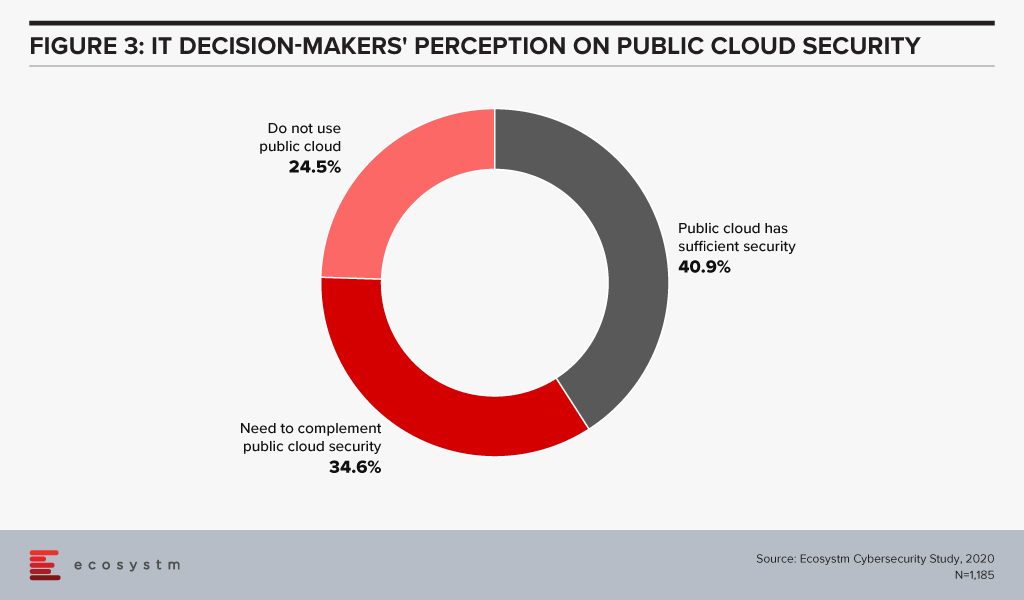
However, the Cloud is as secure as an organisation makes it. The perception that there is no need to supplement Public Cloud security features can have disastrous outcomes. It is important to supplement the Cloud provider’s security with event-driven security measures within an organisation’s applications and cloud interface.
It is the job of the CEO – through the CISO – to evaluate how cyber ready the IT Team really is. Do they know enough about shared responsibility? Do they have full cognizance of the SLAs of their Cloud providers? Do they have sufficient internal cybersecurity skills? Do they understand that data breaches can have cost and reputational impacts? As cybersecurity breaches begin to have more financial implications than ever and can derail an organisation, a CEO should have visibility of the risks of the organisation’s Cloud adoption.
Cloud is no longer just a technological decision – it is a business decision and takes into account the organisation’s vision. A full visibility of the Cloud roadmap – including the pitfalls, the risks and the immense potential – will empower a CEO immensely.

Industry 4.0 has been driving technology adoption and innovation. Technologies such as the Internet of Things (IoT) are being evaluated by Operations and IT teams especially in manufacturing, primary industries and logistics. As we stand on the threshold of widespread 5G rollouts, the industry expects a larger uptake of IoT. However, organisations have found IoT implementations daunting for various reasons – concerns around security, technology integration challenges, customisation, system requirements and so on. The Global Ecosystm IoT Study finds that more than 70% of organisations implementing an IoT solution do not have an IoT strategy team. This has been the key barrier to successful IoT deployments. What is required is a separate IoT solutions team within organisations that reports to the CEO – either directly or through the COO or CFO.
Why should a CEO get involved in and have visibility into an organisation’s IoT projects? There are a few important reasons.
#1 IoT benefits go deeper than process automation
If we look at the top 5 drivers of IoT adoption, we realise immediately that organisations want to do more than automate processes through their IoT deployments (Figure 1). They want to innovate and are looking at IoT adoption to give them an edge over their competition – whether through cost optimisation or through improving the brand image. This cannot be done if organisations look at IoT as a one-off implementation to address one organisational issue – it often becomes a key component of their Digital Transformation (DX) journey.
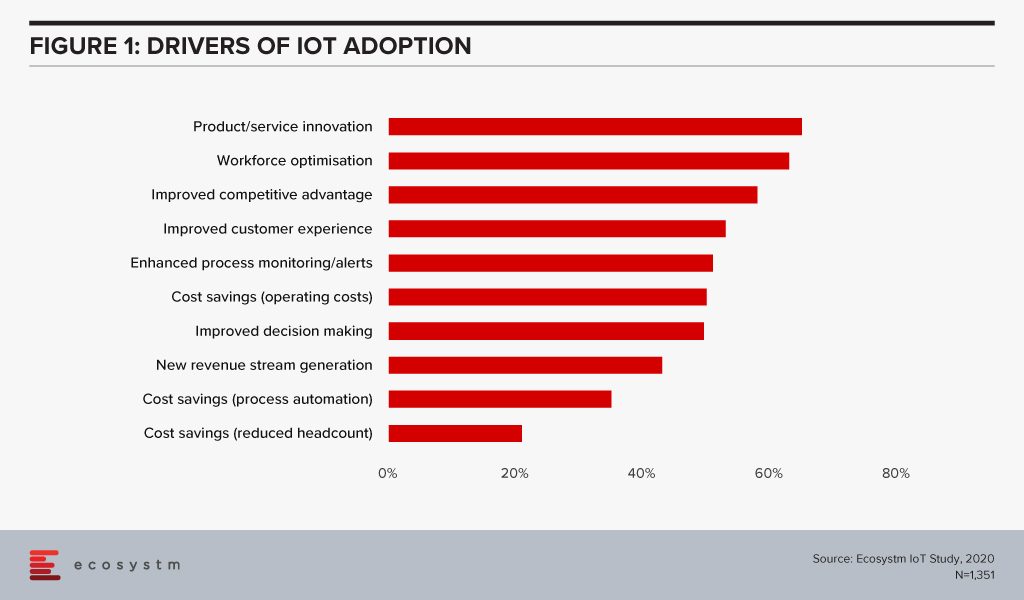
This will require organisations to have conversations that go beyond process automation. The conversation should be about IoT as an enabler of broad corporate initiatives and should be tied back to an overall long-term strategy. The discussions cannot be asset-driven alone, focusing on enabling assets or devices to generate data with no long-term plan on how to use the data. The metrics have to shift to a ‘business outcomes’ group that includes data scientists, corporate marketing, and operations – with the direct involvement of the CEO. The outcomes can be innovative solutions, faster time to market, value-added services or competitive differentiation.
The high volume of real-time data generated by IoT devices can be analysed to develop customised services and solutions. IoT Analytics is driving decisions not just in inventory management and logistics – but in departments such as HR and marketing. Certainly, the CEO would want visibility of that intelligence and should be able to define the intelligence that will help him do his job better.
#2 In some industries at least, IoT will become mainstream
In some industries, IoT solutions have become mainstream – even if there has not been widespread adoption, the discussions about the impact of IoT certainly have (Figure 2). There are early adopters in these industries who have already seen a shift in organisational priorities and benefits derived.

It is the CEO’s job to track the developments and disrupters in their industries. It is the CEO’s job to decide whether the organisation will adopt IoT or not – but it has to be an informed decision. It has to take into consideration the organisation’s culture and capabilities – again that falls under the purview of the CEO.
CEOs in primary industries have to be aware that there are organisations in the industry that are leveraging AI-enabled IoT for cost savings through process automation and for greater visibility of the entire supply chain. Not only are these companies benefitting financially but are also being able to increase the traceability of their products. In agriculture ‘farm-to-fork’ has become a best practice that has the potential to disrupt the industry. Similarly, healthcare CEOs must know that IoT empowers the clinicians immensely, through asset performance management, workforce optimisation and also through the ability to deliver better health outcomes. Again the role of IoT in value-based healthcare is something that CEOs should familiarise themselves with.
#3 Technology disruption will continue to be part of the conversation
No CEO can only focus on business and leave technology to the CIO in today’s disruptive world. There are many technologies that will be part of the larger conversation – and many of these will work in sync with the IoT systems. IoT implementations do not end with installing sensors. While devices, protocols and networks will be handled by CIOs, there are areas where CEOs will have to be consulted, for example, adoption of 5G. Smart Manufacturing and Industry 4.0 initiatives will look to use 5G to gain real-time information to address demand, supply and customer requirements. However, telecom operators are also expected to evolve their existing business models when engaging with enterprises. Changes such as this will require the attention of the CEO.
Another area that will require the CEO’s attention is cybersecurity – millions of devices producing massive data are not only difficult to manage but would also be prone to hacking, network security issues, security breaches and attacks. IoT and other technologies, and the cyber risks associated require the Board and the CEO to evaluate the organisation’s risk exposure including financial remediation. Many organisations have a dedicated responsibility for their cybersecurity practice – the Chief Information Security Officer (CISO) is the key data protection lead and reports directly to the CEO and not to the CIO to avoid a conflict of interest.
As has been mentioned earlier, organisations looking to derive intelligence from their IoT data will need the CEO to play an active role in deciding the nature of the intelligence that is likely to benefit the organisation best. Another area that CEOs will need to have oversight on is the wide range of social, ethical and legal issues that could arise due to the sheer volume of the data collected and the organisation’s data handling practices. Governments across the globe have implemented strict data security and privacy compliance laws. CEOs should be aware of the implications of the data they collect, store, process and use.
#4 IoT projects are not always successful
Implementing and harnessing the true potential of IoT is a big challenge from a CEO’s perspective. Investing in technology and not deriving any benefits could be disastrous for a company in terms of time, effort and cost. CEOs should understand the technology, its integration with the processes and ways to optimise the implementation.
Once the organisation has evaluated the need for an IoT system, it should look at the common reasons why IoT projects fail in other organisations. One of the main reasons is that 98% of organisations have IT teams lead their IoT projects. When you compare this to the 38% of organisations that involve Operations – and that is the function that benefits most from IoT implementations currently – it becomes apparent that key stakeholders are not often involved.
The biggest challenge that IoT implementations face is change management and user adoption. This often gets overshadowed by predominant concerns on technology and cost challenges. The involvement of the CEO and the business functions at an early stage of any IoT deployment helps mitigate that challenge. It would help in not only identifying the right use cases and a better business case but also in higher user adoption because of their involvement (and buy-in) from an early stage. This organisation-wide mandate has to be led by the CEO.
No longer can the CEO focus merely on the business and leave technology to the office of the CIO. Today’s CEO has to be aware of the benefits of technology, the implications for the organisations and the challenges associated with the implementation.



